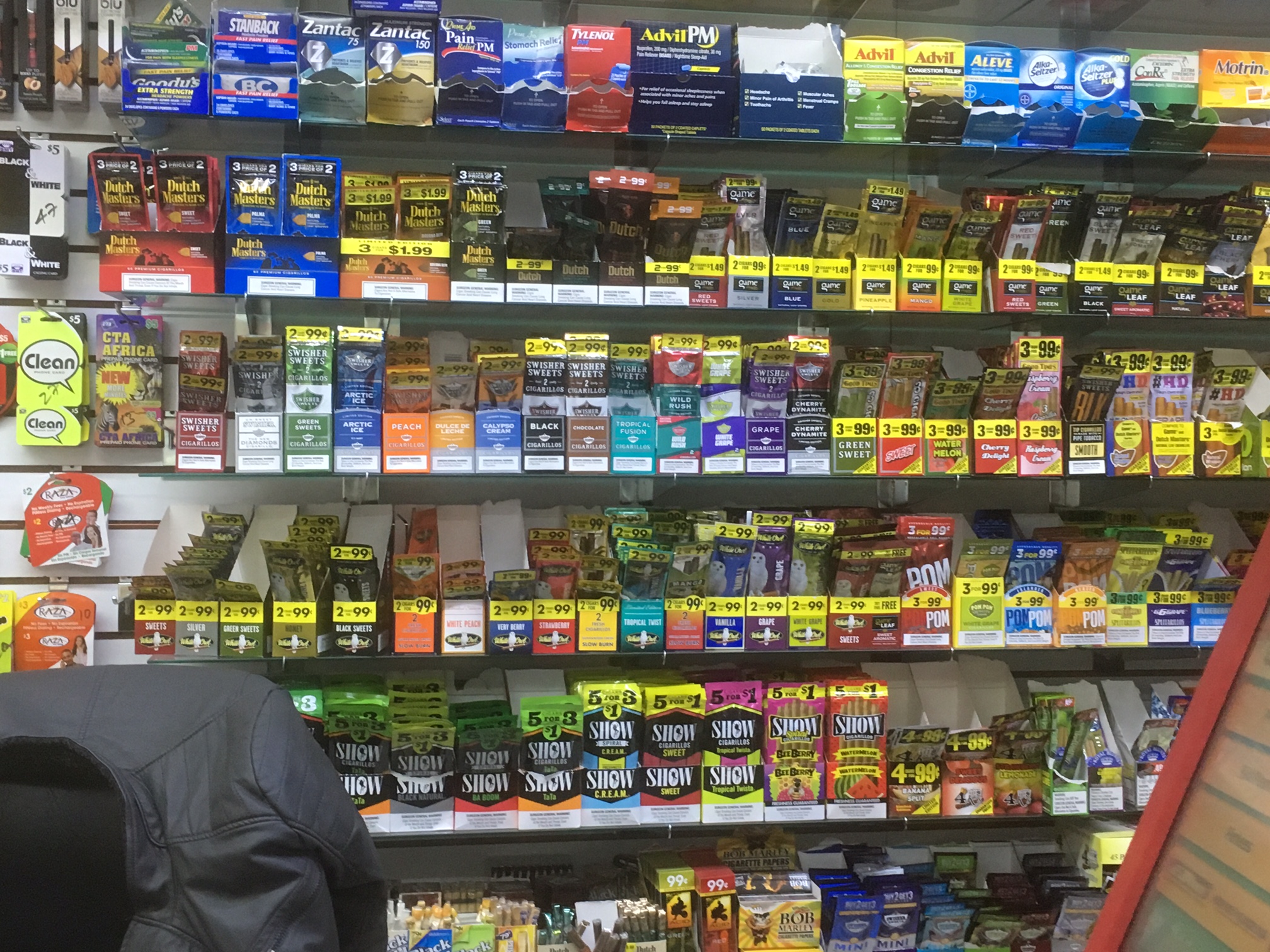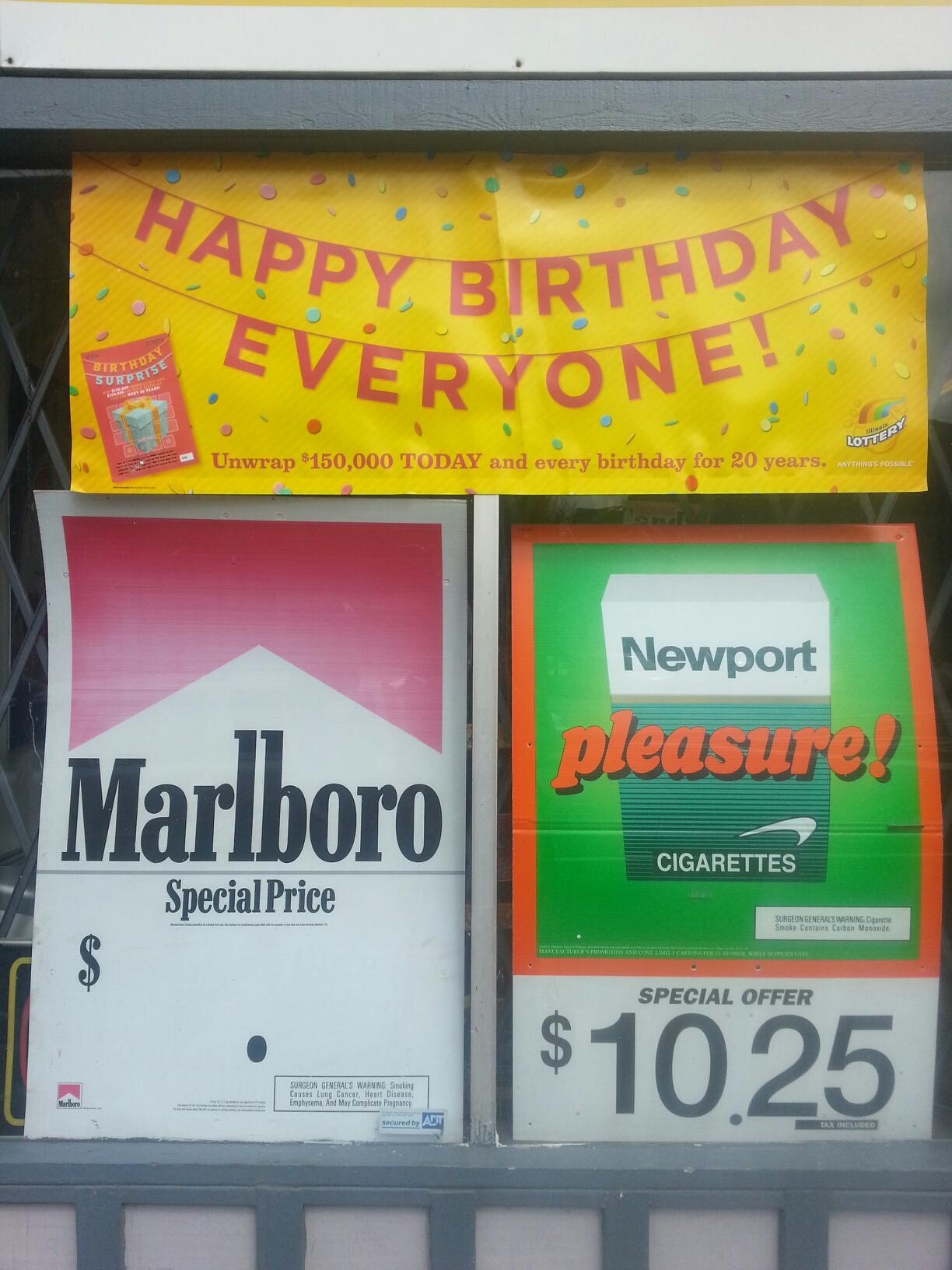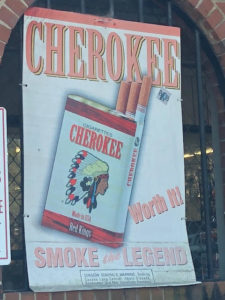Welcome to CounterTobacco.org’s “News and Research Roundup!” Each month we post a summary of the latest research, reports, and news stories on counteracting tobacco product sales and marketing at the point of sale (POS). Keeping up with what’s happening in the POS movement all across the country can help you choose policies and strategies that work best for your community. New research can help provide support for your work and evidence for the importance of the “War in the Store.” Have a story you don’t want us to miss? E-mail it to us!
New Research
Price Policies
- Promising Strategies to Remove Inexpensive Sweet Tobacco Products from Retail Stores, Public Health Reports
-

cheap flavored little cigars This article reviews Boston, MA’s 2012 cigar packaging regulation, which required cigars to be sold in packs of at least four, except in adult-only stores where single cigars are priced at $2.50 or more. The language was later updated to require that packs of two be sold for at least $5.00 and packs of three be sold for at least $7.50. This article describes the process of developing, passing, and implementing the policy, as well as the policy’s effects. The law has since resulted in an increase in average price, a decrease in the number of retailers selling single cigars, and a reduction in disparities in youth access to cigars across neighborhoods, race, and income. Learn more about minimum pack size and minimum prices for cigars.
-
- Price elasticity of demand of non-cigarette tobacco products: a systematic review and meta-analysis, Tobacco Control
- This study analyzed 36 other studies from 15 countries and found that a 10% increase in price would result in an 8.3% decrease in demand for cigars, a 6.4% decrease in demand for roll-your-own tobacco, and a 2.1% decrease in demand for smokeless tobacco. The studies included on cross-price elasticity showed that in high income countries, as prices increase for non-cigarette tobacco products (except for smokeless and roll your own), demand for cigarettes increases. This data indicates that price increases can be an effective tool to reduce consumption of non-cigarette tobacco products, and to avoid substitution, policies should increase prices for all tobacco products simultaneously. Learn more about non-tax policies that raise the price of tobacco.
- Impact of tobacco control policies on adolescent smokeless tobacco and cigar use: a difference-in-differences approach, BMC Public Health
- This study analyzed data from the Youth Risk Behavior Surveys and state tobacco taxes between 1999 and 2013. Researchers found that chewing tobacco taxes and cigar taxes had no impact on the use of chewing tobacco and cigars among adolescents 14-19 years old. However, they also found that a 10% increase in cigarette taxes was associated with a 1.0% increase in smokeless tobacco use among males, a 1.5% increase in cigar use among males and a 0.7% increase in cigar use among females. Smoke-free legislation was associated with 1.1% increase in smokeless tobacco among males. This data indicates that policies like tax increases should be applied to all tobacco products and that comprehensive tobacco control policies are needed in order to reduce tobacco use.
- News Story: Higher cigarette taxes may increase use of smokeless tobacco and cigars in adolescents, Medical Express
- This study analyzed data from the Youth Risk Behavior Surveys and state tobacco taxes between 1999 and 2013. Researchers found that chewing tobacco taxes and cigar taxes had no impact on the use of chewing tobacco and cigars among adolescents 14-19 years old. However, they also found that a 10% increase in cigarette taxes was associated with a 1.0% increase in smokeless tobacco use among males, a 1.5% increase in cigar use among males and a 0.7% increase in cigar use among females. Smoke-free legislation was associated with 1.1% increase in smokeless tobacco among males. This data indicates that policies like tax increases should be applied to all tobacco products and that comprehensive tobacco control policies are needed in order to reduce tobacco use.
Advertising and Displays
-

Marlboro and Newport are two of the most popular brands among youth - An analysis of the National Youth Tobacco Survey showed that Marlboro, Newport, and Camel were the three most common “usual brands” smoked by middle and high school students. Three brands were preferred by 73.1% of middle school smokers and 78.7% of high school smokers. Students also reported advertisements for these three brands as their favorite cigarette advertisements. Among current smokers, 72.1% identified the same brand that they usually smoked as the brand of their favorite cigarette advertisement. While tobacco companies claim they do not market to youth, their ads clearly reach and engage them.
- Global evidence on the effect of point-of-sale display bans on smoking prevalence, Tobacco Control
- An analysis of data from 2007-2014 across 77 countries showed that having a point-of-sale display ban reduced adult daily smoking by 7%, male smoking by 6% and female smoking by 9%.
- “Their Packaging Has Always Been Like a Power”: A Qualitative Study of U.S. Smokers’ Perceptions of Cigarette Pack Visual Design Features to Inform Product Regulation, International Journal of Environmental Research and Public Health
- The qualitative study was comprised of six focus groups with 33 participants selected for their diversity. Participants reported that the color of cigarettes packs was the most salient design element for them. Participants described the color of packaging as representing characteristics of the product, such as taste and strength. Participants also found logos and graphics, typography, and the pack itself to be important design elements as well, catching their eye and conveying other characteristics of the product. Changes to the pack design can draw consumers’ attention or change their perception of a product. This study provides additional evidence that changes to the visual design of a cigarette pack can affect consumer behavior, and researchers suggest that the design should be regulated under the Tobacco Control Act.
Menthol and other Flavored Tobacco Products
- Menthol cigarettes and the public health standard: a systematic review, BMC Public Health
- This systematic review of 82 studies found that the removal of menthol from cigarettes would likely reduce youth smoking initiation, make it easier for adults to quit, and benefit public health. Fifteen years of national studies have shown that youth are more likely to smoke menthol cigarettes than adults and the proportion of youth who smoke menthol cigarettes is growing. Nine studies, one of which was longitudinal, showed that menthol smokers were more nicotine dependent than non-menthol smokers. Ten studies showed that menthol smokers had less success quitting smoking than non-menthol smokers.
- News story: Will Removing Menthol Cigarettes Benefit Public Health?, Medical News Bulletin
- This systematic review of 82 studies found that the removal of menthol from cigarettes would likely reduce youth smoking initiation, make it easier for adults to quit, and benefit public health. Fifteen years of national studies have shown that youth are more likely to smoke menthol cigarettes than adults and the proportion of youth who smoke menthol cigarettes is growing. Nine studies, one of which was longitudinal, showed that menthol smokers were more nicotine dependent than non-menthol smokers. Ten studies showed that menthol smokers had less success quitting smoking than non-menthol smokers.
- Harm Perceptions of Menthol and Nonmenthol Cigarettes Differ by Brand, Race/Ethnicity, and Gender in US Adult Smokers: Results from PATH Wave 1, Nicotine & Tobacco Research
- Data from the Population Assessment of Tobacco and Health (PATH) study showed that 40% of current smokers used menthol cigarettes. Prevalence varied by brand, with 94% smoking Newport, 46% smoking Camel, and 18% smoking Marlboro menthol cigarettes. However, 80% of all menthol smokers perceived their cigarettes as equally harmful as other brands, 14% thought they more harmful, and 7% thought they were less harmful. Menthol smokers were also more likely than non-menthol smokers to view their own brand as more harmful than other brands, though this associated varied by race and gender.
- Flavored Cigars Appeal to Younger, Female, and Racial/Ethnic Minority College Students, Nicotine & Tobacco Research
- Among 18-29 -year-old college students who currently use cigars, nearly 75% preferred flavored cigars. Students who were younger, female, of a racial/ethnic minority were significantly more likely to prefer flavored cigars than other students. In addition, students who currently smoked marijuana, had ever used blunts, or who reported using cigars because they were affordable and/or available in flavored that they liked were also more likely to choose flavored cigars than other students. Students who smoked both cigarettes and cigars, those who reported using cigars because of their cheaper price and because smoking cigars felt like smoking cigarettes were also more likely to prefer flavored cigars. Learn more about flavored tobacco products.
E-Cigarettes
- E-Cigarette Use Among Adolescents Not Susceptible to Using Cigarettes, Preventing Chronic Disease
- Data from the 2015 North Carolina Youth Tobacco Survey showed that among students who were not susceptible to smoking cigarettes, those who viewed e-cigarettes or secondhand e-cigarette vapor as more harmful were less likely to currently use e-cigarettes or be susceptible to e-cigarette use. However, students who were not susceptible to smoking cigarettes but who were exposed to e-cigarette vapor in indoor or outdoor spaces were 5 times as likely to currently use e-cigarettes and nearly twice as likely to be susceptible for future e-cigarette use. This suggests that interventions which communicate the harms of e-cigarettes and limit e-cigarette use in public places could decrease e-cigarette use by youth who are not susceptible to cigarette use.
- News Story: Some Kids Saying No to Smoking Are Saying Yes to Vaping, Newswise
- Data from the 2015 North Carolina Youth Tobacco Survey showed that among students who were not susceptible to smoking cigarettes, those who viewed e-cigarettes or secondhand e-cigarette vapor as more harmful were less likely to currently use e-cigarettes or be susceptible to e-cigarette use. However, students who were not susceptible to smoking cigarettes but who were exposed to e-cigarette vapor in indoor or outdoor spaces were 5 times as likely to currently use e-cigarettes and nearly twice as likely to be susceptible for future e-cigarette use. This suggests that interventions which communicate the harms of e-cigarettes and limit e-cigarette use in public places could decrease e-cigarette use by youth who are not susceptible to cigarette use.
- Impact of E-Cigarette Minimum Legal Sale Age Laws on Current Cigarette Smoking, Journal of Adolescent Health
- This study showed that raising the minimum legal sales age to 21 for e-cigarettes does not increase youth cigarette use when adjusting for individual level covariates (e-cigarette and other tobacco use, sex, race/ethnicity, and age) and state-level covariates (smoke-free laws, cigarette taxes, medical marijuana legalization, income, and unemployment). Learn more about Tobacco 21 laws and e-cigarettes at the point of sale.
- Reasons for Electronic Cigarette Use Among Middle and High School Students – National Youth Tobacco Survey, United States, 2016, CDC MMWR
- Middle and high school students’ most common reasons for using electronic cigarettes in 2016 were because friends or family used them (39%); because they are available in flavors such as mint candy, fruit, or chocolate (31%); and because they believe they are less harmful than other forms of tobacco (17%).
- State Restrictions of e-Cigarette Use Has Slowed, JAMA
- State legislative activity on e-cigarettes peaked in 2015 but has slowed since then.
- Inflammatory and Oxidative Responses Induced by Exposure to Commonly Used e-Cigarette Flavoring Chemicals and Flavored e-Liquids without Nicotine, Frontiers in Physiology
Other
- State-Specific Prevalence of Tobacco Product Use Among Adults – United States, 2014-2015, CDC MMWR
- Ever-use of any tobacco product ranged from 27.0% in Utah to 55.4% in Wyoming
- Current use of any tobacco product ranged from 10.2% in California to 27.7% in Wyoming
- Cigarettes were the most common currently used tobacco product, and cigarette users who reported currently using one or more other tobacco products ranged from 11.5% in Delaware to 32.3% in Oregon
- Eight of the ten states with the lowest prevalence of current tobacco use have comprehensive smokefree policies, and seven out of the ten states with the highest tobacco use prevalence do not have comprehensive smokefree laws.
- Evaluation of California’s ‘Tobacco 21’ law, Tobacco Control
- An evaluation of California’s policy raising the minimum legal sales age for tobacco from 18 to 21 showed that seven months after the policy went into effect, 98.6% of retailers were aware of the new policy, and 60.6% of retailers were in support of it. The retailer violation rate (RVR) using youth under the age of 18 as decoys decreased from a 10.3% violate rate before the policy went into effect to 5.7% seven months afterwards .The RVR using young adults 18-19 years old as decoys was 14.2% for conventional tobacco and 13.1% for electronic smoking devices. Tobacco-only stores and vape shops were most likely to make an illegal sale, while pharmacies and supermarkets were least likely. The authors conclude that high awareness and support for the Tobacco 21 law may have contributed to it’s effective implementation.
- Public misperception that very low nicotine cigarettes are less carcinogenic, Tobacco Control
- This study found that 47.1% of smokers believed that very low nicotine cigarettes (VLNC) are less likely than conventional cigarettes to cause cancer, and 23.9% of smokers said that would be less likely to quit if the US adopted a very low nicotine cigarette standard. The belief that VLNC are less likely to cause cancer was more prevalent among smokers over the age of 55 (56.6%) and black smokers (57.4%). Researchers suggest that if the US does adopt a very low nicotine cigarette standard, a communication campaign about the dangers of toxic chemicals in very low nicotine cigarettes may help reduce misperceptions and increase effectiveness.

- This study found that 47.1% of smokers believed that very low nicotine cigarettes (VLNC) are less likely than conventional cigarettes to cause cancer, and 23.9% of smokers said that would be less likely to quit if the US adopted a very low nicotine cigarette standard. The belief that VLNC are less likely to cause cancer was more prevalent among smokers over the age of 55 (56.6%) and black smokers (57.4%). Researchers suggest that if the US does adopt a very low nicotine cigarette standard, a communication campaign about the dangers of toxic chemicals in very low nicotine cigarettes may help reduce misperceptions and increase effectiveness.
- Tobacco industry misappropriation of American Indian culture and traditional tobacco, Tobacco Control
- A search of the Truth Tobacco Documents Library revealed that the tobacco industry has been incorporating American Indian culture and traditional tobacco into their marketing tactics since at least the 1930s, though “Red Man” chewing tobacco was first introduced in 1904. Tobacco companies have used American Indian imagery (e.g. traditional headdresses and other cultural symbols) in their branding and advertising, misappropriating, co-opting, and stereotyping traditional tobacco use by some American Indian tribes to validate and make a profit off of commercial tobacco. These findings highlight the need for monitoring of tobacco industry marketing tactics as part of comprehensive measures to reduce the influence and harms of commercial tobacco.
New Reports
- State of Tobacco Control, American Lung Association
- Public Health Consequences of E-Cigarettes, National Academies of Science, Engineering, and Medicine
- News story: E-Cigarettes Likely Encourage Kids to Try Tobacco But May Help Adults Quit, National Public Radio
Industry News
- Newport’s appeal with millennials chips away at Marlboro’s top market share, Winston-Salem Journal
- Retailers Optimistic on Reduced-Risk Tobacco Products, Convenience Store News
POS Policy in the Media
- ‘Uneven Progress’ in U.S. Smoking Decline, US World News & Report
- Small cigarette wholesalers accuse large companies of violating state tax laws, Times Union
- Saugus Board of Health denies request to raise tobacco permit cap, Wicked Local Saugus
FDA
- Judge may force FDA to speed up graphic tobacco warnings, Reuters
- D.A. Panel Rejects Philip Morris’ Claim That Tobacco Stick Is Safer than Cigarettes, New York Times
Menthol and other Flavored Tobacco Products
- Duluth clamps down on flavored tobacco sales, Duluth News Tribune
- New Jersey Could Be First State to Ban Menthol Cigarettes, Associated Press
- Menthol Cigarettes Could Be Even Worse Than Regular Cigarettes, Vice Daily Tonic
- Editorial: Base a menthol ban on policy, not profits, NorthJersey.com
- County may ban flavored tobacco, including menthol, San Mateo Daily Journal
- Possible ban on sale of menthol cigarettes, flavored tobacco for Oroville, Action News Now
- Youth campaign targets flavored tobacco products, Times Argus
Tobacco 21
- North Mankato passes Tobacco 21, Mankato Free Press
- Rexburg Ups Legal Age to Buy Tobacco, State Law Being Reviewed, Fox News Radio 1310 KLIX
- Bill to raise smoking age to 21 dies in committee with just 3 senators supporting it, Spokesman-Review
- Indiana Could Become the 6th State to Increase Smoking Age to 21, Fortune
- As Smoke-free Illinois turns 10, lawmakers propose raising age for tobacco sales to 21 statewide, Chicago Tribune
- NH Senate tables bill to raise tobacco age to 21, Seacoastonline.com
- Under-21 Tobacco Sales Ban Rejected by South Dakota House, US News
- Statewide Effort Launched To Support Raising Tobacco Sale Age in Connecticut, PR Newswire
- Proposed Bill Would Raise Smoking Age in Alabama, WKRG
- Ulster County lawmakers expected to consider raising legal age of purchasing cigarettes to 21, Daily Freeman News
Find more stories in last month’s News and Research Roundup.
Know of a story that we missed? Email us, and we’ll be sure to include it in next month’s roundup!


